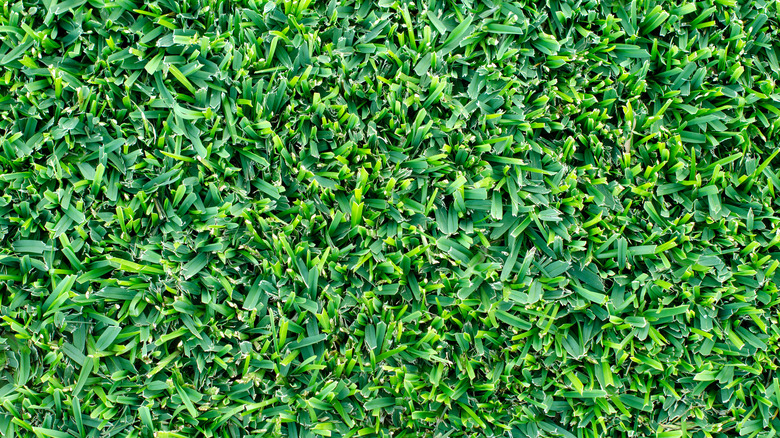The Downsides To A Buffalo Grass Lawn
As the lone, native prairie grass worth its name, buffalo grass (Buchloë dactyloides), named for assuaging the hunger of foraging American bison, has become immensely popular among those seeking low-maintenance ways to create an eye-catching front lawn. When left unmowed and supplemented with wildflowers and tubers, it mimics a natural landscape. But that's precisely what ticks off the admirers of manicured lawns. With blades that retain their soft, glaucous color all summer long without assuming the dark green hues most lawns are favored for, it just never feels like the right fit for some yards.
To boot, compared to cool-season grasses, such as fescue and bluegrass, it takes longer to wake up, greening only when half the spring season is long past; early spring irrigation is of no help. Worse, it doesn't even make up for the delayed greening, choosing to grow latent as soon as the first frost hits during fall. Naturally, not many gardeners appreciate the prolonged season of unruly, straw-like, brown turf that persists through the winter.
Buffalo grass doesn't survive shade, sand, and high foot traffic
Although buffalo grass has a lot going for it: indigenous parentage, wildlife value, and drought- and heat tolerance, such benefits come to naught if it isn't planted in the right location. For starters, you can kiss the dreams of spending quality family time amidst swaying grass blades goodbye if you sod the grass in a shaded spot. It needs at least six to eight hours of sun exposure to keep its growers happy. Plus, it has trouble surviving in elevated zones, drawing the line at 6,500 feet. It also shows very little tolerance for salt and aluminum. Indeed, a 2005 study published in the International Turfgrass Society Research Journal found that buffalo grass lost over 55% of its root mass in soils rich in aluminum.
Moreover, if your lawn has sandy or poorly draining soils, buffalo grass is unlikely to thrive for long without incremental irrigation. That being said, you must hit the mark on watering, as excess will invite weeds, and it's more prone to being outcompeted. That's why it's unsuitable in areas receiving heavy rainfall. But if you end up underwatering your lawn, it will hit dormancy sooner, losing its characteristic bluish-green tint. Further, consistent, concentrated foot traffic is not its jam; only people who use their yards sparingly and keep their potlucks on the low should consider this grass.
Buffalo grass is expensive and difficult to establish
Buffalo grass lawn is a labor of love. Since its seeds are walled by hardy glumes, they have a tough time germinating. In fact, only 20% of the seeds have any chance of seeing the light. This is assuming they can be harvested since the female plants are rooted deep underground, which also explains why their seeds are priced higher than their counterparts. Hence, it's often recommended to only plant "treated seeds," as they've been winter-chilled for nearly two months to achieve greater germination success (sits at under 90%).
Unfortunately, despite the chemical treatment, grass seeds can take up to two years to fully establish themselves. Moreover, they lack the dense clumping habit common to fescue grasses. Add to that, as the turfgrass is finely textured, it spreads thinly in the initial years, giving way to weeds. This sets in motion a host of new problems. As buffalo grass is prone to bruising and browning, it cannot be treated with most post-emergent herbicides unless it's grown fully latent, ultimately necessitating professional help. Plus, the use of pre-emergent treatments during seeding as a premeditated measure to kill weeds in your lawn isn't recommended. It even has trouble fighting off fellow turfgrasses until it has rooted itself completely, writing off all propositions of overseeding. Under such circumstances, an easier way out is to use plugs or sod, although they can be prohibitively expensive.


